It´s really a part of yachting that is often neglected, quickly forgotten when a new boat has finally hit the water and excitement of ownership and sailing takes over. With only a very few exceptions, every yacht ever built in the world will make her very first trip … on roads. Really, if you think about it, it´s a bit ridiculous, but almost every single yacht is driven over tarmac by large heavy duty transports to the sea. So basically, your sailing adventure starts with a driving adventure. In the truest sense of the word: As most shipyards, especially those of the big production boat companies, aren´t located directly by the sea, yacht transport by truck (or “lorry”, as our friends in the United Kingdom would prefer to say) is both a matter of course and a super interesting world of its own.
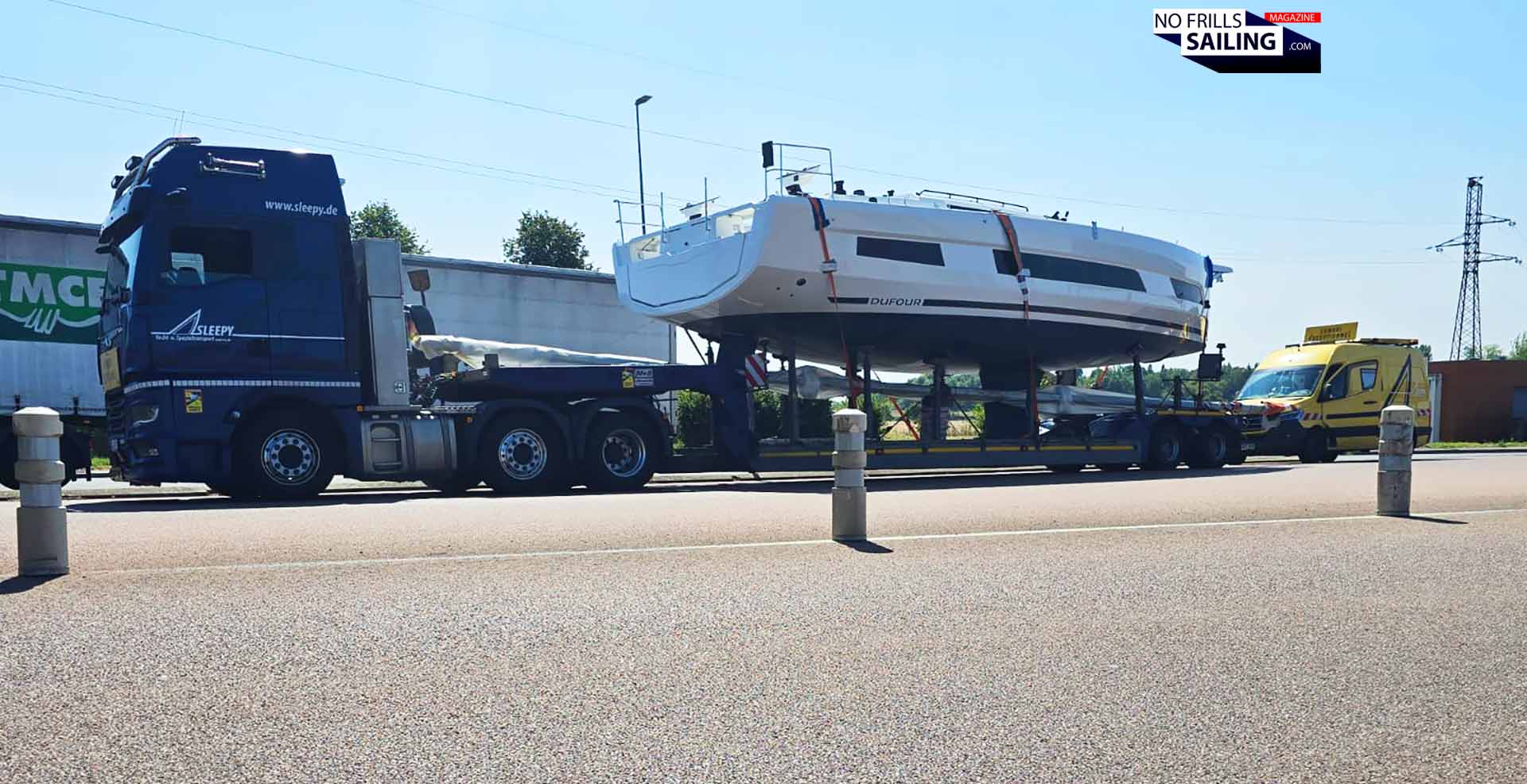
The shipyard of Bavaria Yachts is located in Giebelstadt, deep, deep inside of Germany: That´s an 800 kilometer trip to the Adriatic. Bringing your brand new Nautor´s Swan from Jakobstad to the ferry terminal in Turku/Finland is a 400 kilometer drive as well. Even the big French shipyards, whilst said to be located in the Vendée at the Atlantic Ocean … aren´t: For a new Beneteau Oceanis built in Le Poiré sur Vie it´s a 50 kilometer trip to Les Sables d´Olonne for commissioning, a La Rochelle built Dufour (made in Perigny, an industrial zone outside of the city) will be driven 15 kilometers to the water at least.
At the yacht transport company´s HQ
There are two reasons for me to write this article. First is the fact, as I mentioned before, that many yacht owners, especially first time buyers, often neglect and even do not know anything about this fascinating world of boat transports. Secondly – and there is a close connection between the two – in buying a yacht, it´s often the price of the transport that is heavily negotiated and sadly driven down. Of course, everyone should get the “best price”, no doubt about that, but too much bargaining is one cause for less and lesser quality. It´s a problem, really. So I took the chance to speak with my personal favorite yacht transport company, Sleepy of Germany, about these issues.

Visiting the crew at their Kiel headquarters a few weeks ago, the drivers, dispatchers and people who make sure that your precious new yacht (or even your old one) is brought from A to B as quick as possible, as fast as possible and without any damage or hustle. And this, believe me, is a really gripping story! In fact, a story that needs to be told because these guys make a fantastic job but rarely get the credit they deserve.

Arriving at Sleepy HQ in Kiel, many of the trucks are parked in front of the administrative building. It´s a rare occasion, because usually the dispatchers would make sure that the trucks are on the road: Minimizing downtime and idling periods between each transport is the prime job of the dispatchers. Trucks only earn money when they drive. In particular, they need to drive carrying load. On that very day, a Friday, the company had invited the bulk of the drivers to attend one of the regular training courses. Advanced training, obtaining qualifications and keeping up with ever changing rules is paramount in the heavy duty hauling business. Especially in bureaucratic Germany and the European Union. Good for me: I have a lot of guys to talk to.
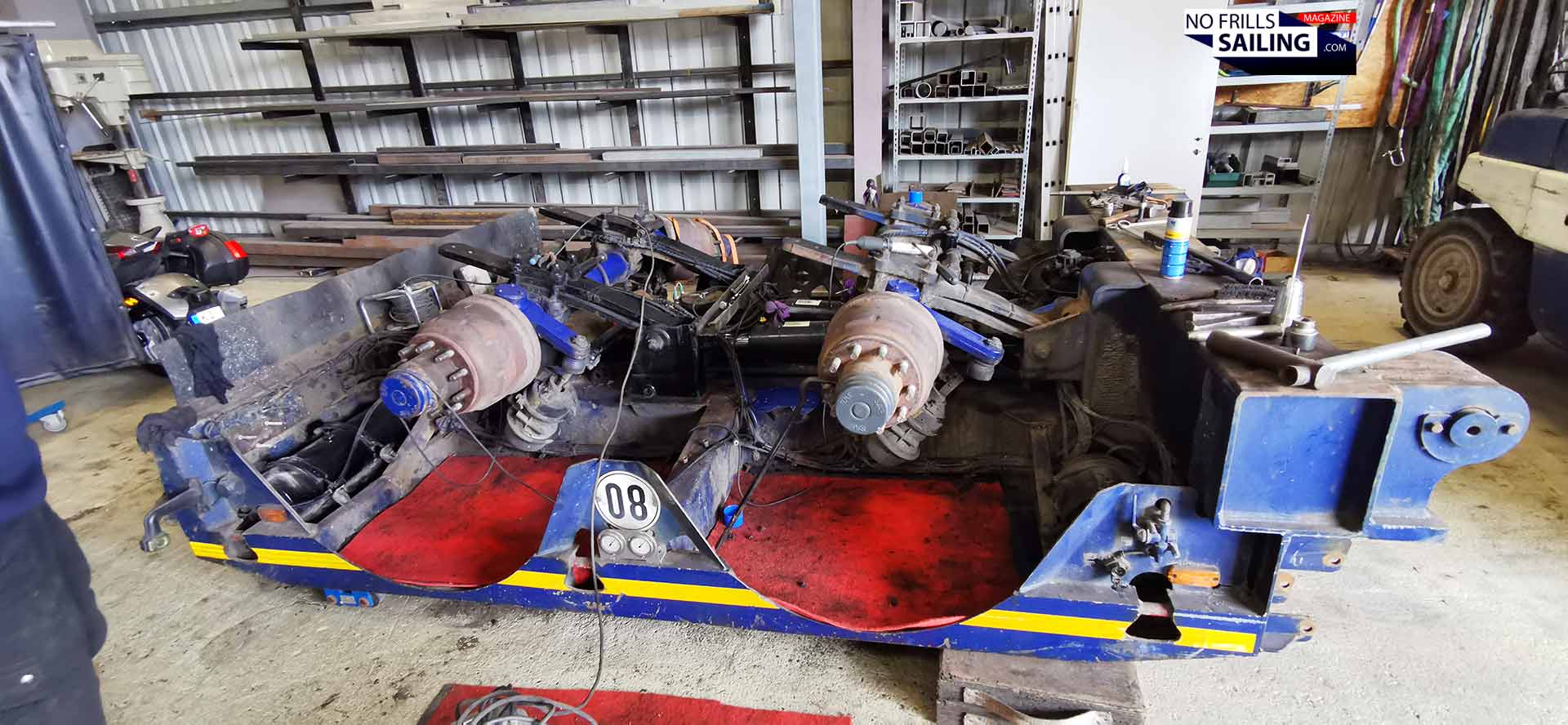
First thing I notice is that – Sleepy at least – have their own big-ass truck workshop. It´s a big hall with everything you´d suppose to find in an auto-repair, but bigger. With a fleet of more than a dozen heavy duty special-purpose trucks (and their respective trailers), maintenance and repairs is a huge topic. It makes sense to not outsource this task but to employ mechanics who are trained and get specialized in your own hardware. “Heavy duty” implies … heavy duty, so it´s no wonder that there is frequent wear and tear on the equipment. You simply cannot afford to have your truck stuck by failure somewhere in Europe. Did you ever need towing or road assistance in a remote area, possibly in a foreign country? The bills a truck-rescuer issues is manyfold …
Welcome to my crib … truck room tour
I´m a guy. And I´m honest: Who does not dream of becoming a trucker at one point in your life? It´s a fascinating occasion, big machine, high above the tarmac: I ask one of the truckers if he could give me a room tour aboard his truck, which he agreed to do. You have to understand that the drivers, any truck driver, spends not only the whole worktime on the driver´s seat in these things, but also his spare time when underway. It´s both a workplace and their home.

That is why almost all truck drivers have a very special connection to their trucks, individualize them and add lots of personal touch to make it more comfortable, more bearable. I climb into the driver´s seat. It´s reacting to my body weight and an automatic pump adjusts the suspension. Very smooth, the seat is absolutely comfortable: No comparison to your ordinary car.
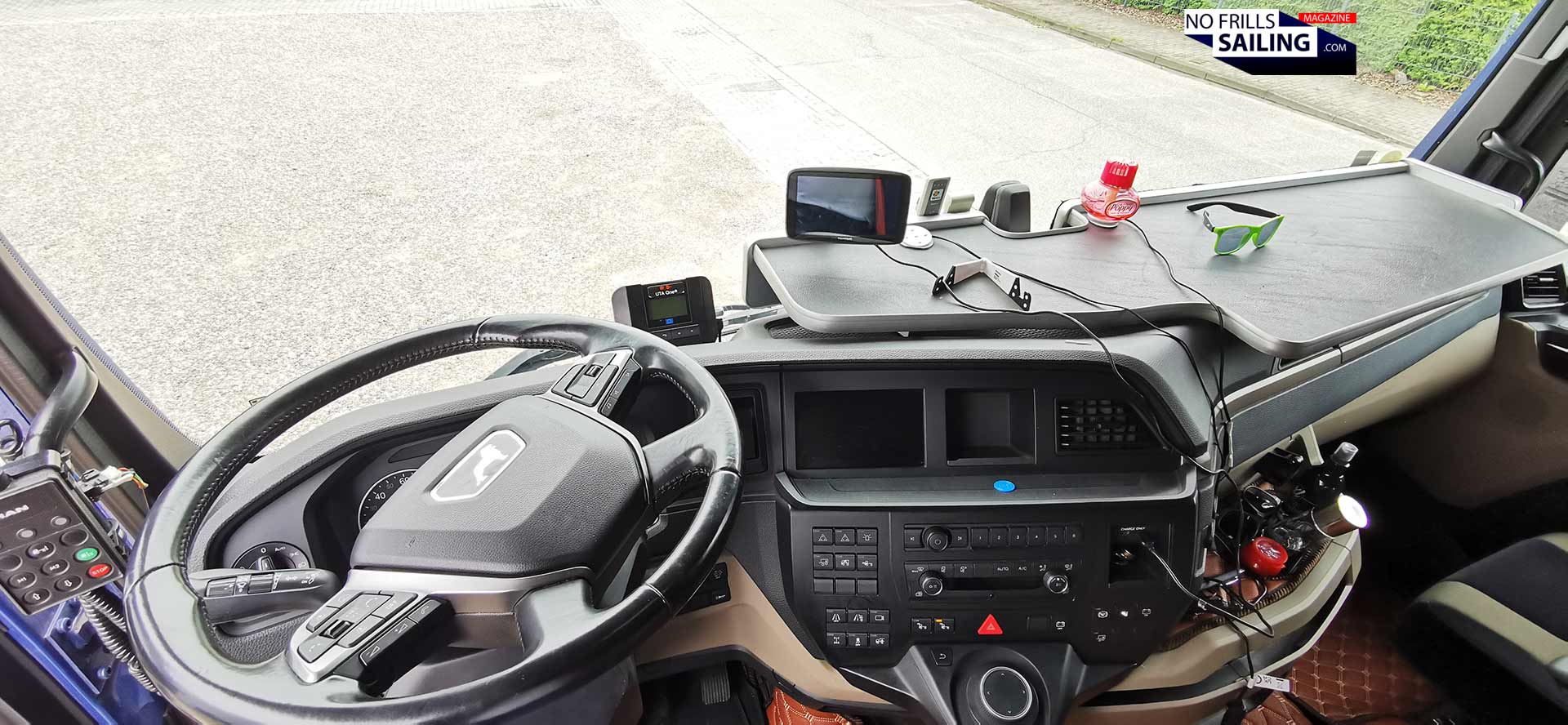
The view from up here, what is it, like three meters? The view is great: At least when it comes to stuff that is in front of me. It gets more complicated when I try to make out what´s behind or next to me. You know the yellow stickers, indicating blind areas and dead corners around a truck? “Angles Mortes” as they say, at least here in Europe. Well, even though there are no less than four big mirrors mounted in various angles, some trucks additionally even boast camera systems and sensors, it´s frightening how little I can really see! And there isn´t even load behind me: Imagine hauling an oversized yacht with excess width? And I´m not been talking accidents with people here – taking a corner alone is a work of art and demands loads of competence!
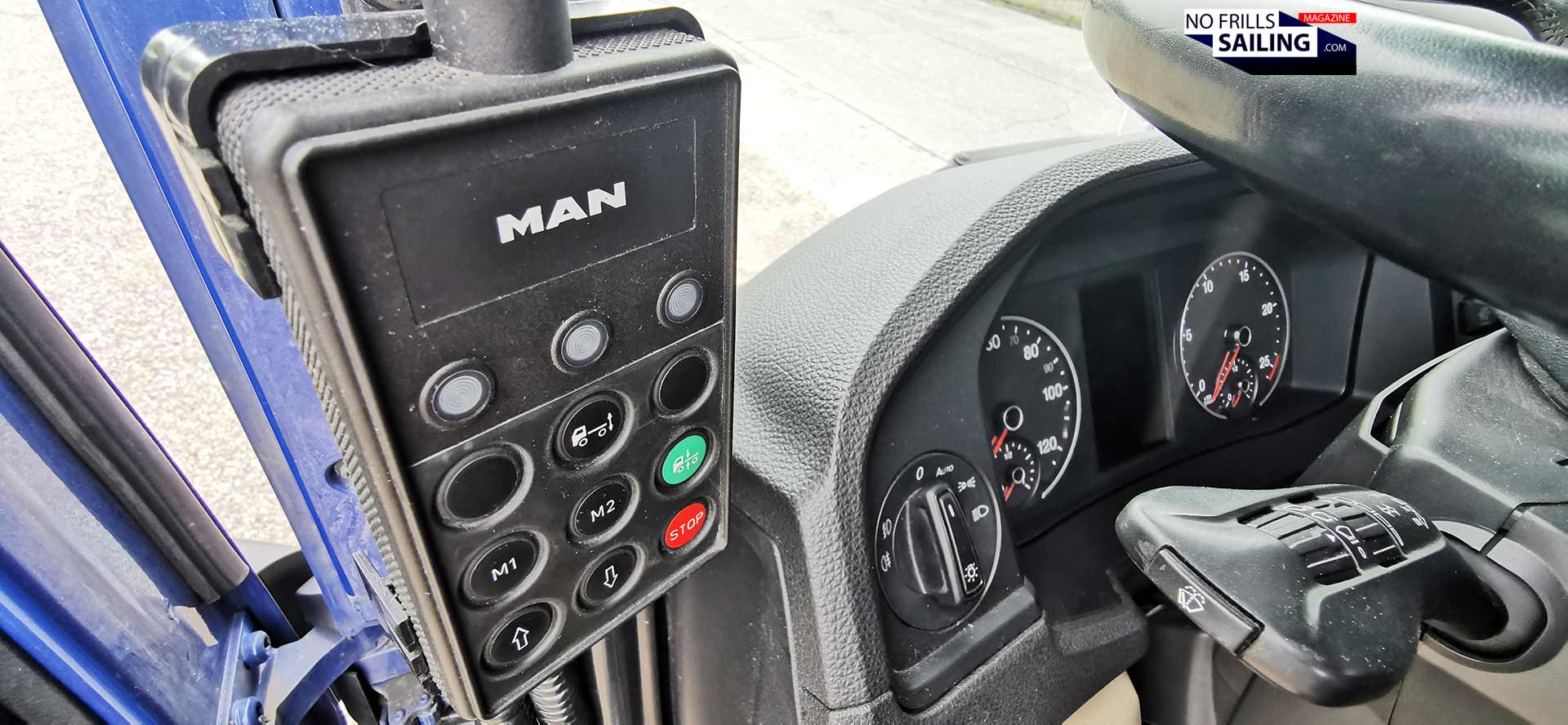
These trucks are your standard MAN, Scania or Volvo drawing vehicles which are customized either by the manufacturer or later by specialized workshops to fit the needs of their respective companies. For hauling excess load and excess dimension-freight, yu of course need a lot of signaling lights, flashlights and beacon lights. There are a number of them, demonstrated by the driver who shows me around. Each light has its own range of appliance, fired up in regards to the freight or circumstances.
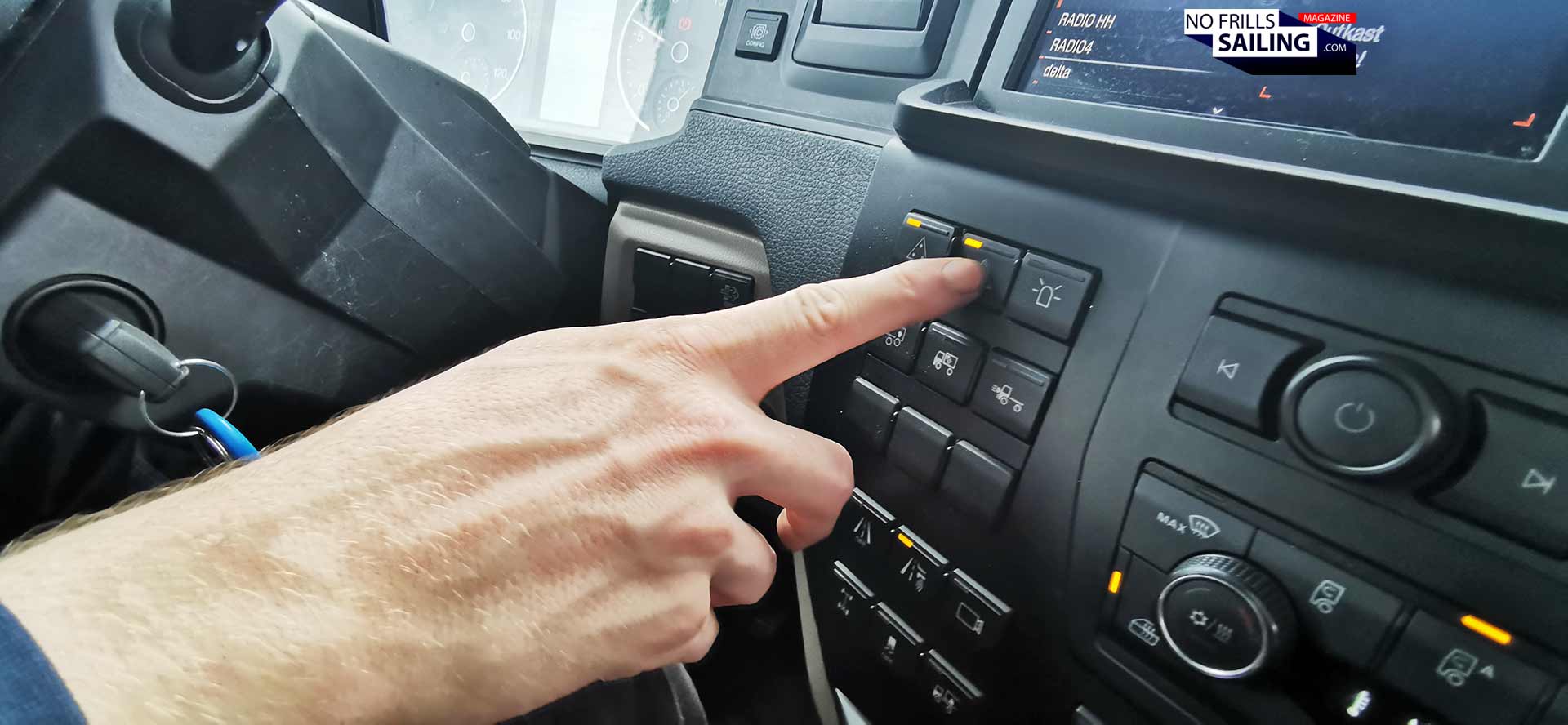
There´s also the famous CB radio, or “citizen´s band” frequency radio transmitter aboard the truck. I have to smile a bit because when I was a young boy, 8th or 10th grade in school, I used to operate one stationary of these too. (I grew up in a small 3.000 souls village In the middle of nowhere). It´s still in use today, but not so much for communicating from truck to truck, as I suspected, but more for talking to your pilot car. “The old romantic days of trucking are mostly gone.”, that´s what they tell me here in unison: No more announcements or warnings via CB from trucker to trucker when there´s a traffic jam, police control or something like this. Digital services mostly replaced it, but also the fact that freight hauling – like so many other businesses – has become a very tough reality.
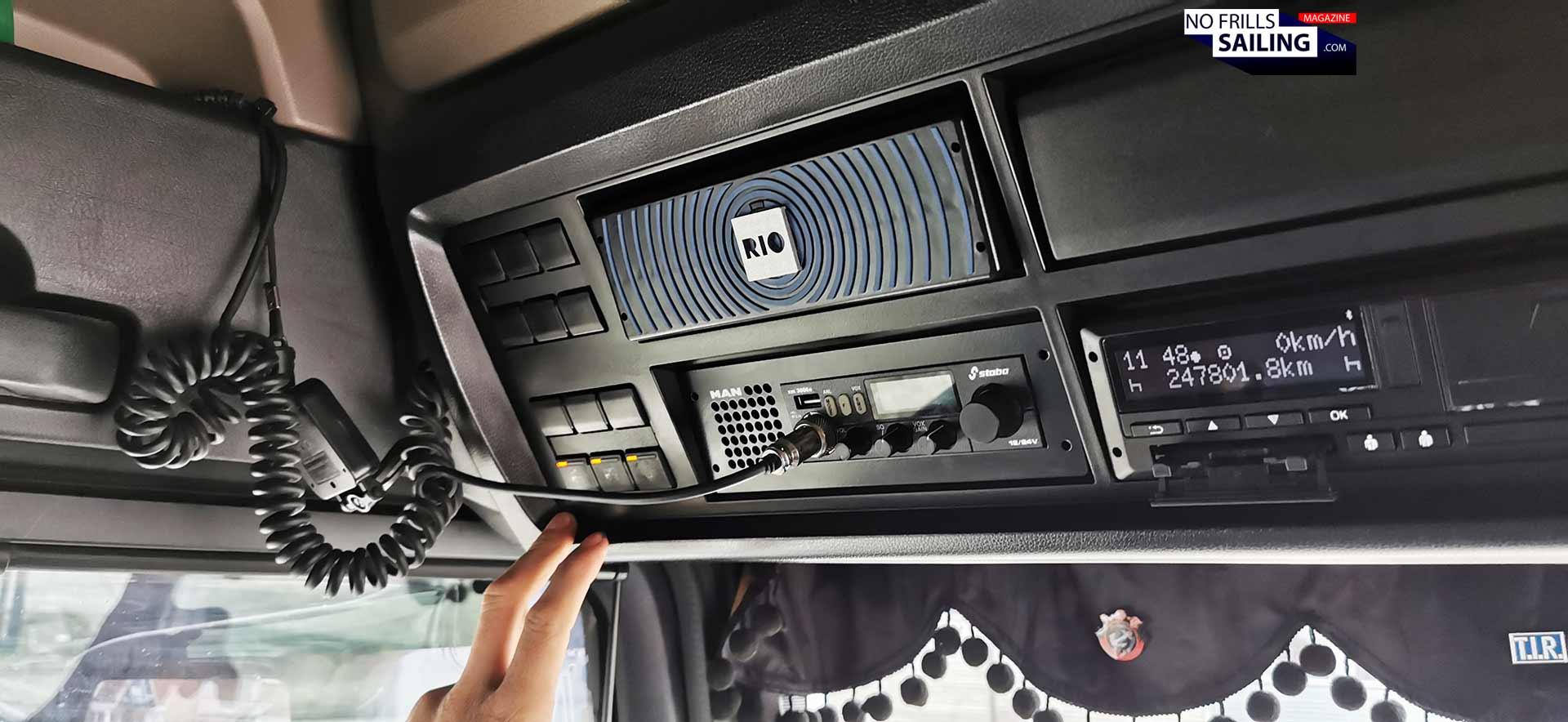
The driver´s cab has a lot of other interesting things to talk about. Road toll is one of them. Most European countries ask for toll on their big roads, many of which force trucks to go on paid roads. It´s ridiculous again, that in our European Union, where even the size and curvature of a banana is regulated by EU-wide rules, there´s no EU-wide toll system. This is why on the front window of the truck multiple digital so-called “on board units” are installed. At least you don´t have to stop and pay manually at every gate …
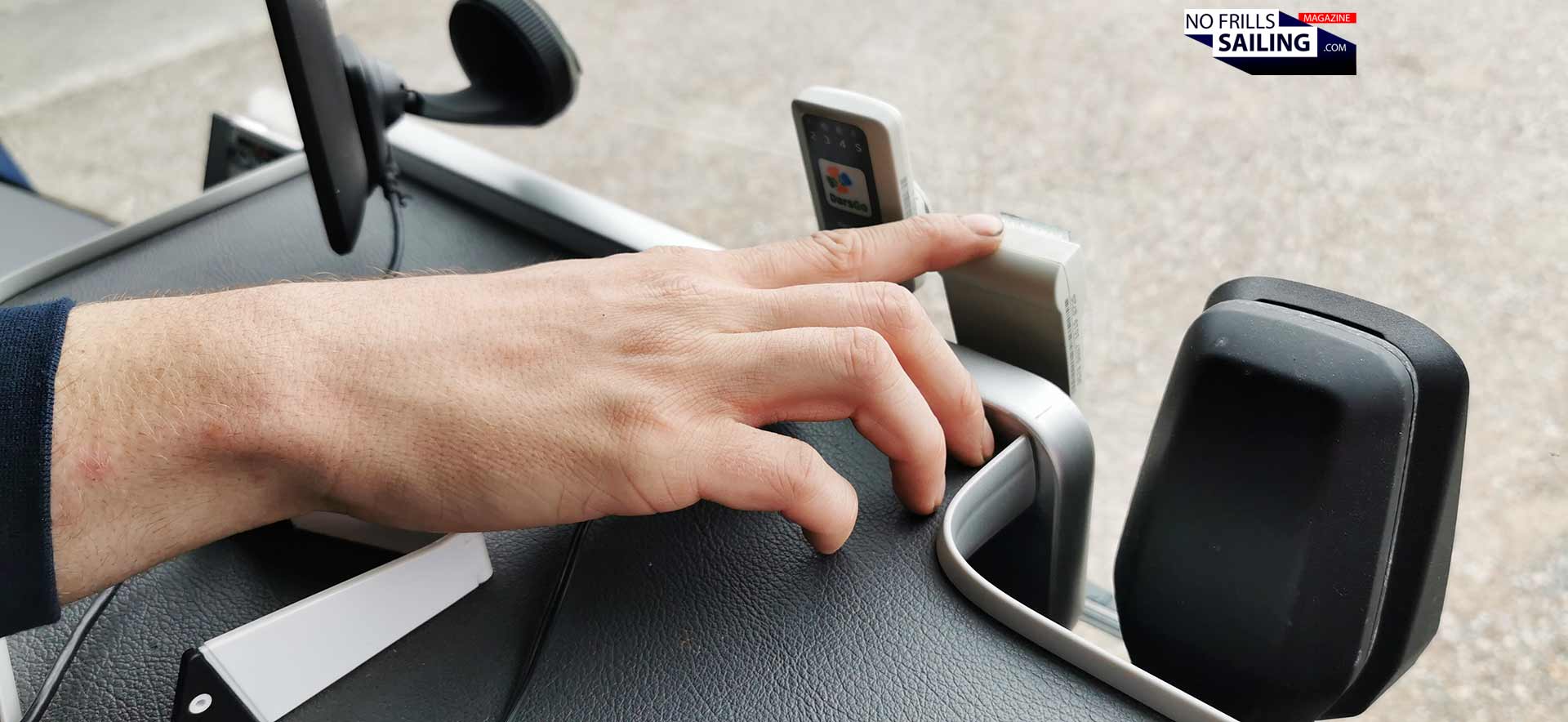
The cabin of the truck is both cozy and very practical. Everything is well within reach for the driver. There is AC of course, a nice radio or HiFi-unit to play your favorite songs and lots of amenities. Over time, as one driver tells me, you would start to customize your truck to tailor-fit the needs. Surplus cooling capacity, fold-away tables, lots of trays and also, of course, decoration. Most important, as it seems to me, is the floor cover and the arrangement of the front window. One thing is for sure: “License plates with your name in the front is frowned upon!” No Sleepy truck has one.
Not unlike a boat: Truck comforts underway
What is regulated in unison however here in Europe is the driving time for a heavy duty transport. When underway, it´s a daily amount of nine working hours behind the whell which is allowed maximum. After four and a half hours, the transport must stop for at least 45 minutes before being allowed to carry on. On two days per week the driver is allowed to have two days of maximum excess driving time of 10 hours. As for the pauses, these can be splitted into 15 and 30 minute breaks.
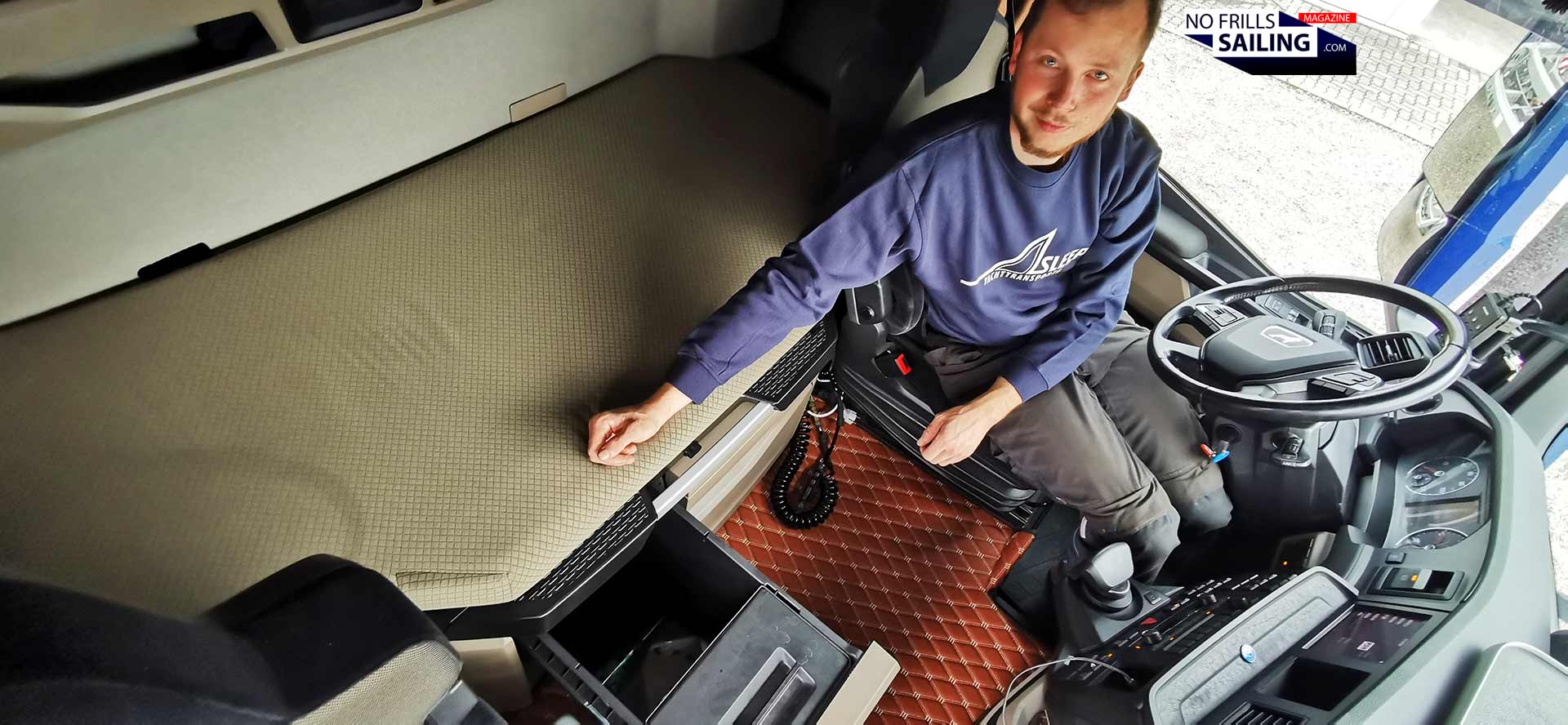
That said, for a transport that can only go at 60, or 80 kilometers an hour – maximum 90 kilometers per hour – sleeping in the truck becomes a necessity. The drivers need to have a daily downtime of 11 hours minimum. In the back of the truck a nice, long, surprisingly cozy bunk is located. Each driver will bring his own bed linen to fit his needs. Depending on the duration of the trips, the truck manufacturers can fit all sorts of sizes and amenities into the trucks with the one shown being pretty standard. A yacht transport transversing Europe rarely takes longer than 5 days.
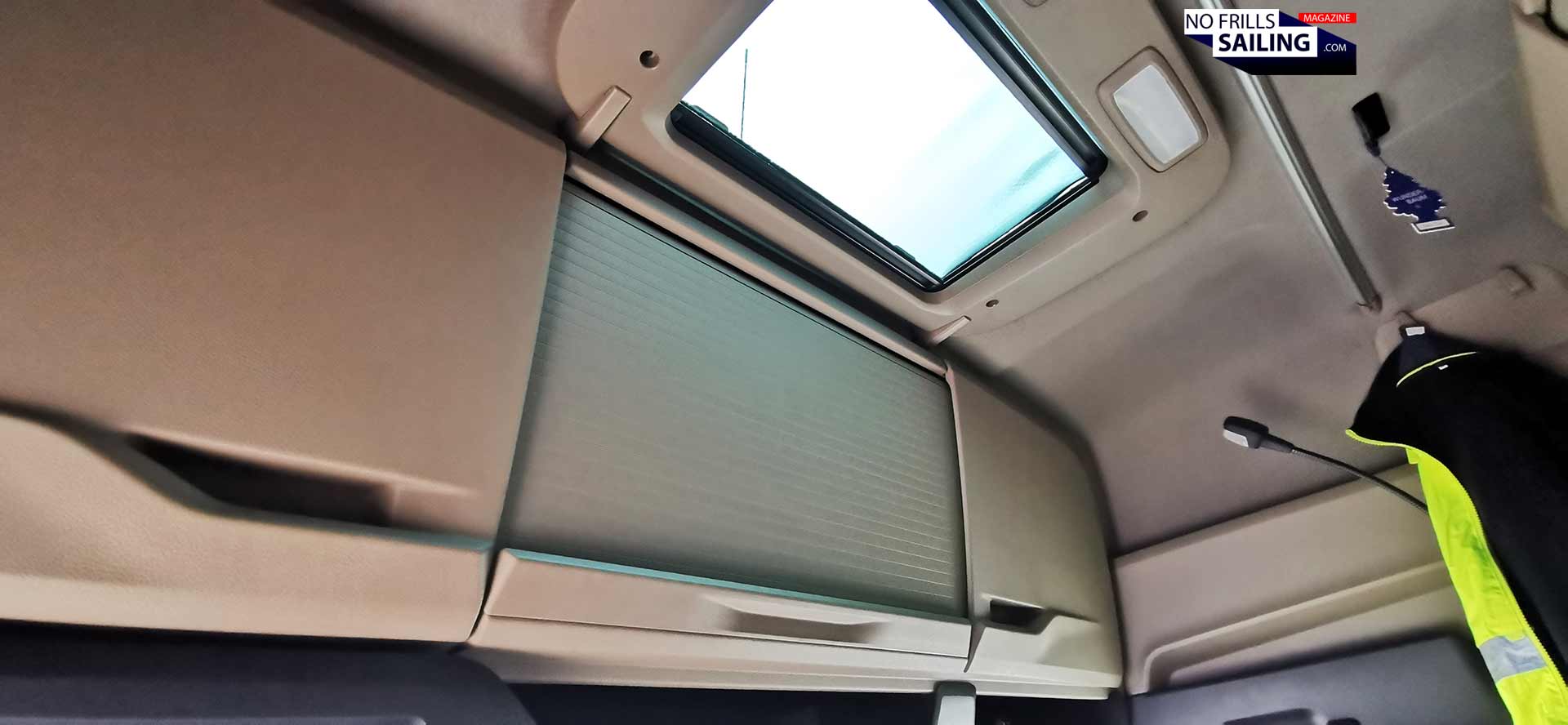
Above and below the bunk a large modular stowage is fitted. Lots of stuff to be packed away here, like clothing: A truck transport that starts in the North of Finland for example will make the driver wear winter clothing; whilst unloading can be in southern Greece or Turkey, where he´d need to have summer clothing. Underneath the bunk fridge drawers can be fitted with drinks (non-alcoholic, of course!) and food. Talking of food: That´s a special topic for truckers …
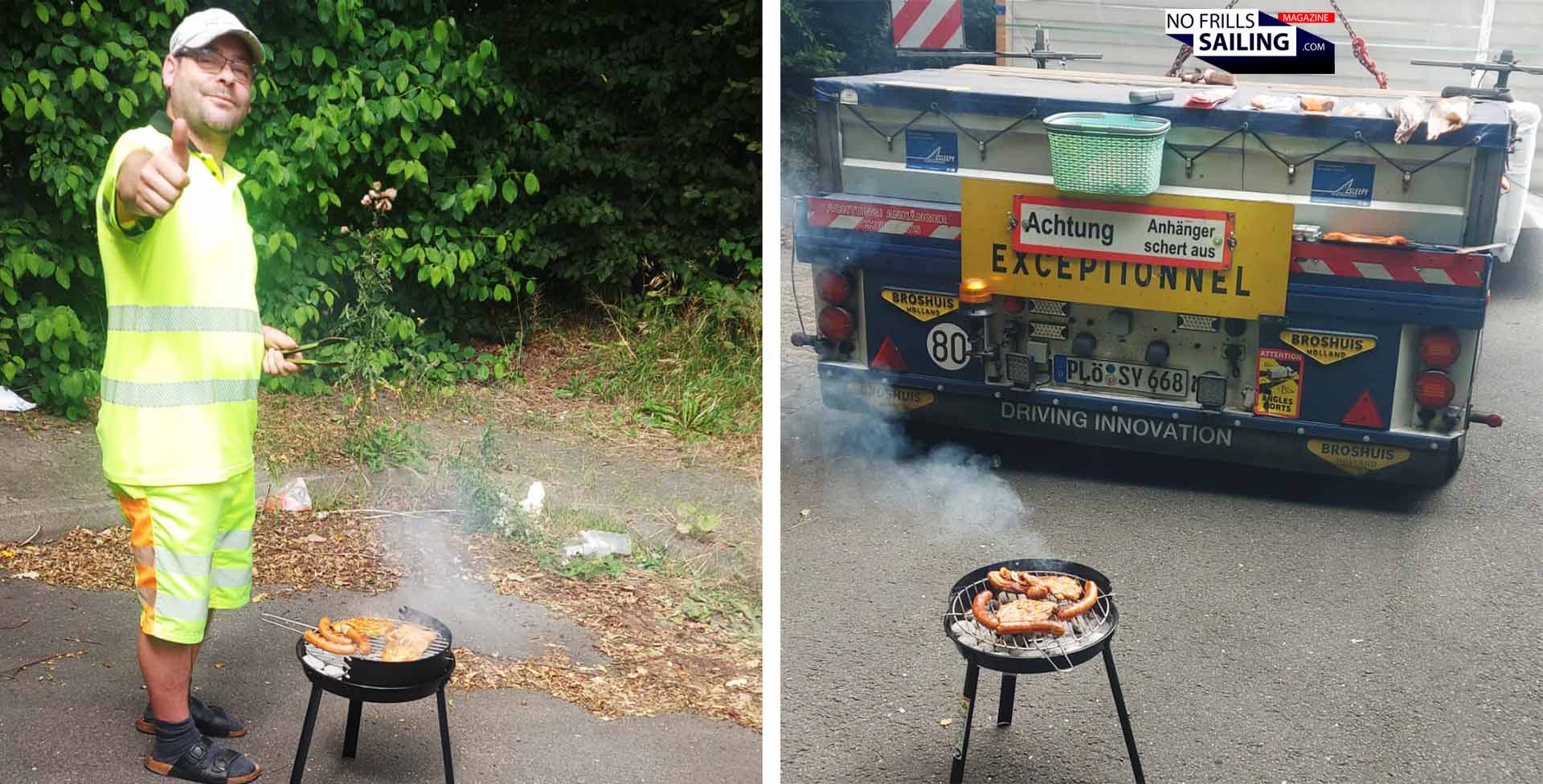
As there are multiple pauses to take and there´s a Sunday or weekend lorry ban in almost all of Europe, eating becomes a big thing. As I was driving a lot during my active times as boat dealer as well, I know how much more money you spend on food when underway: Even if there are truck stops where restaurants feature a special “trucker´s price”, the most convenient and money-saving way to eat is to cook for yourself. Most fun of course is summer time, when you can enjoy a BBQ underway or a Sunday´s feast with – now it´s allowed – a local wine or craft beer. Some drivers, as one shows me, have even fitted complete gas-fired kitchens within the sides or the back of the trucks. It seems like leastwise a tiny bit of trucker romance still prevailed …
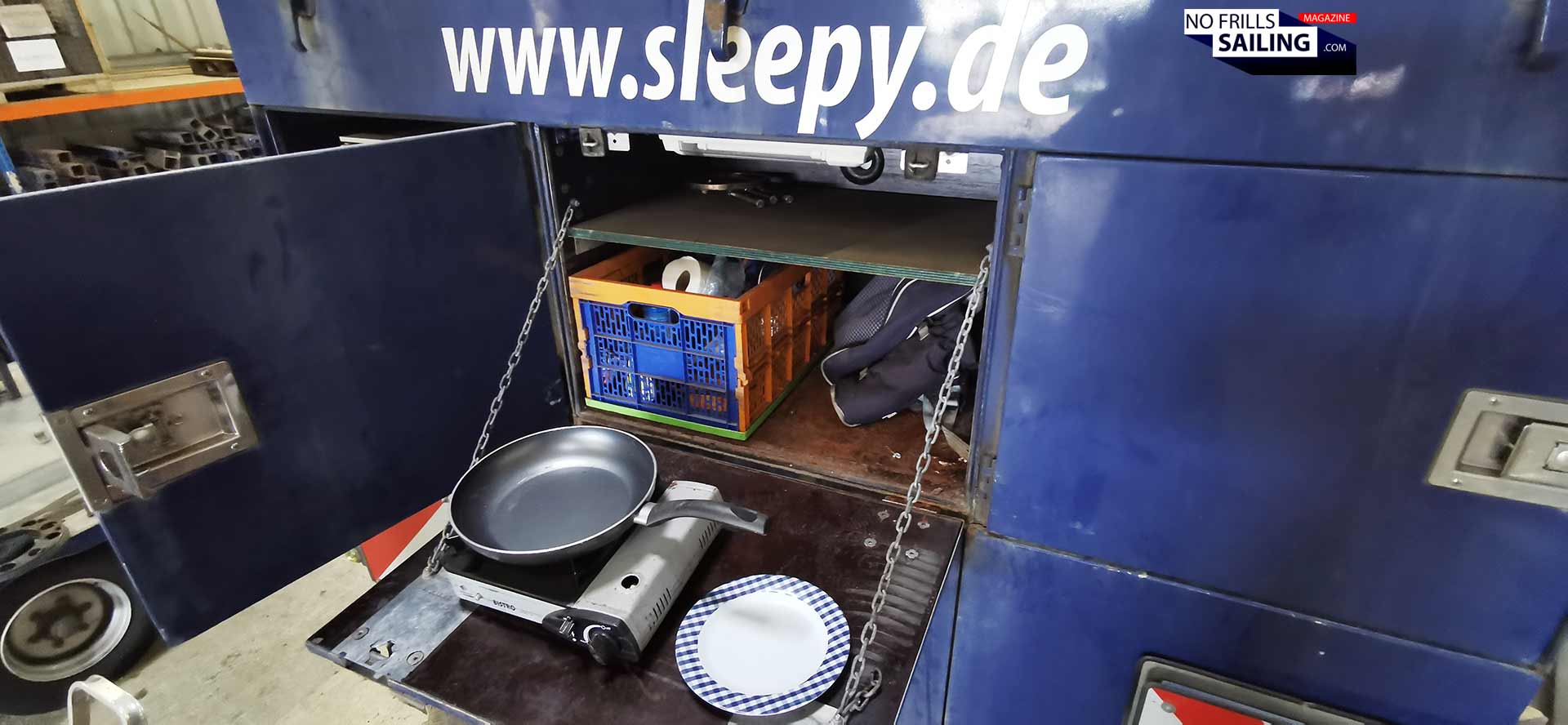
But is it so? Most, even the young guns, shake their heads and deny it. The business has changed completely over the past 20 years. This sounds like long ago, but “20 years ago” means 2005. The defiance or, how should I call it, kind of grumpy mood displayed by the drivers has a lot to do with the extraordinary tough competition by cheap labor flowing after the eastward expansion of the EU. Falling freight rates may be a good thing for purchasers, but it has almost ruined the job, one tells me. It´s not as bad as with ordinary trucking, heavy duty hauling, especially yachts, has not been hit as hard. But still, this job is far from the idealistic picture we might have in our heads …
Truck driver romantics?
I don´t want to delve deeper into the inner-European issues which are considered the main driver for a kind of deterioration of this job´s attractiveness. The pay, albeit sufficient, is not very high as a lorry driver whereas the demands and stress-level is through the roof. The digitalization may have made administrative works become much easier, but it also had a negative impact on the drivers. One of the guys pulls out the paper discs which used to bee part of the classic tachographs. “This is a thing of the past”, he tells me: Everything is digital now.

The digital odometers include a trip recorder that saves everything from driving time, distances and for some systems even telemetry, like speed and such. Tracking of the trucks is a common thing: And a two-sided sword. On the one hand, dispatchers here at the Sleepy HQ (and thus their clients) can receive a life feed from their freight´s position. This enables the company to plan the jobs with pinpoint accuracy. Combined with weather data and traffic information, this is indeed a very powerful tool. Downtime can be minimized, routes optimized and new jobs assigned to the drivers whilst underway. Really, digitalization has transformed the business: There are less empty trips, trucks earn more.

The downside of all of this really is the problem that many more other businesses face as well: My dad used to be a fighter-pilot, later flying for airlines. He told the same stories of how digitalization kind of “killed” the old style of the jobs. Commercial shipping? The same. “You become kind of a glass-person.”, one discloses: “It takes a while to accommodate, not that we have anything to hide. But being tracked so closely all of the time is something you have to get used to.” By that, every truck driver seems to be in a hurry nowadays, resulting in less comradery, less consideration among the drivers and at times even high stress. On the other hand: “You get used to it and you still can arrange a pretty neat life on the road for yourself”, one says. But it takes special guys for this job.
How to become a heavy duty truck driver?
So how do you even become a yacht truck driver? As for Sleepy, who have been in the business for almost 40 years now, the driver is the one big essential part in the whole system. They take pride in their roster of well-trained, experienced specialists. There is a reason why I – back in my days of being a boat dealer – almost always awarded yacht transport jobs to Sleepy. Their drivers are load masters too and bring a huge amount of boat-specialized knowledge. Not just “ordinary” truckers!
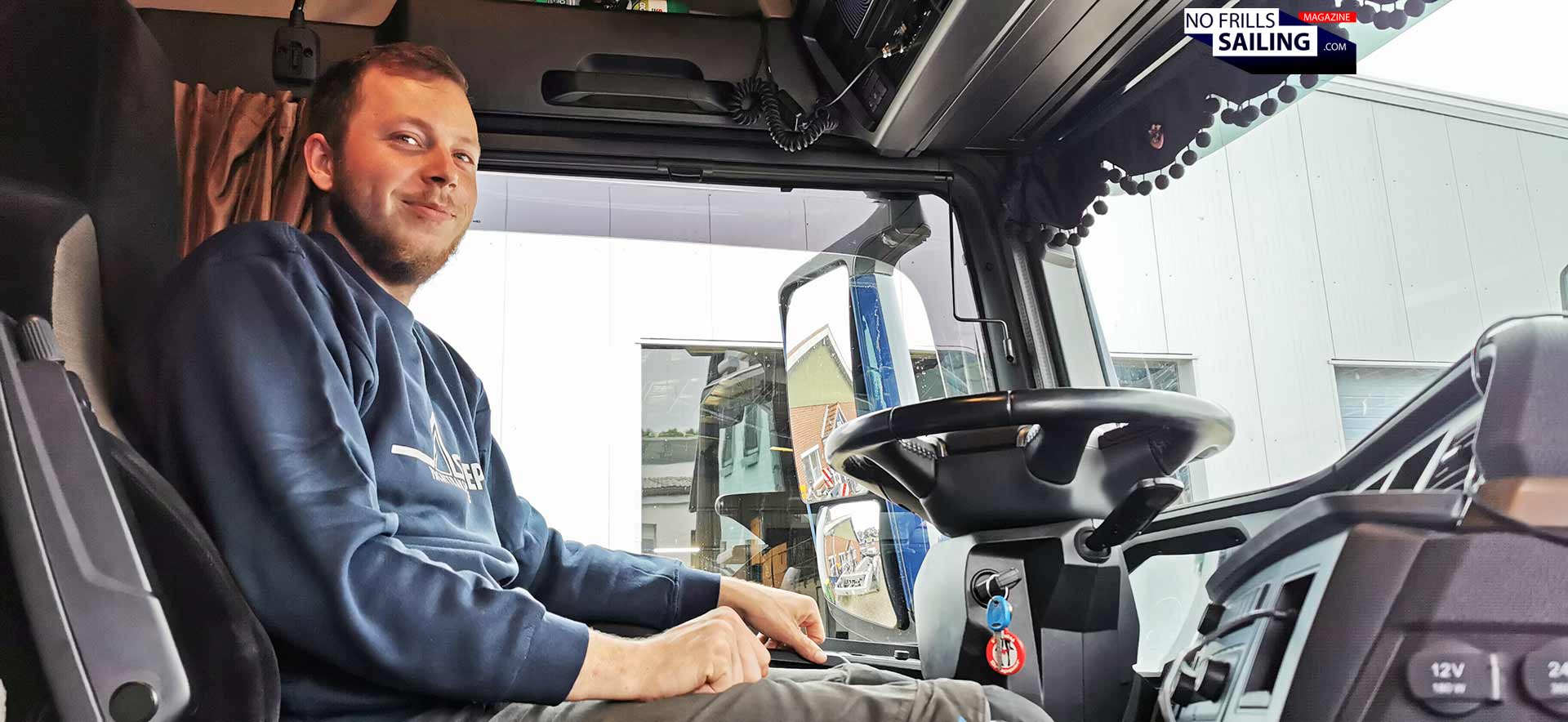
You usually start your heavy duty yacht truck driver career with the ordinary truck driver´s license. That´s a precondition for your application even being considered. Furthermore, you need a professional driver´s qualification which enables you to drive for commercial purposes. A number of special qualifications and licenses are needed to pass. Some companies require the minimum age of their drivers being 21 years. As for Sleepy, even with all regulatory hurdles passed, you won´t get on the driver´s seat right from the start. Usually, you will take the co-driver´s seat first and do some transports as assistant. Maybe you will drive the pilot car (later more on that) too, in order to get accustomed to heavy haul transportation and the specialty of yacht transport.
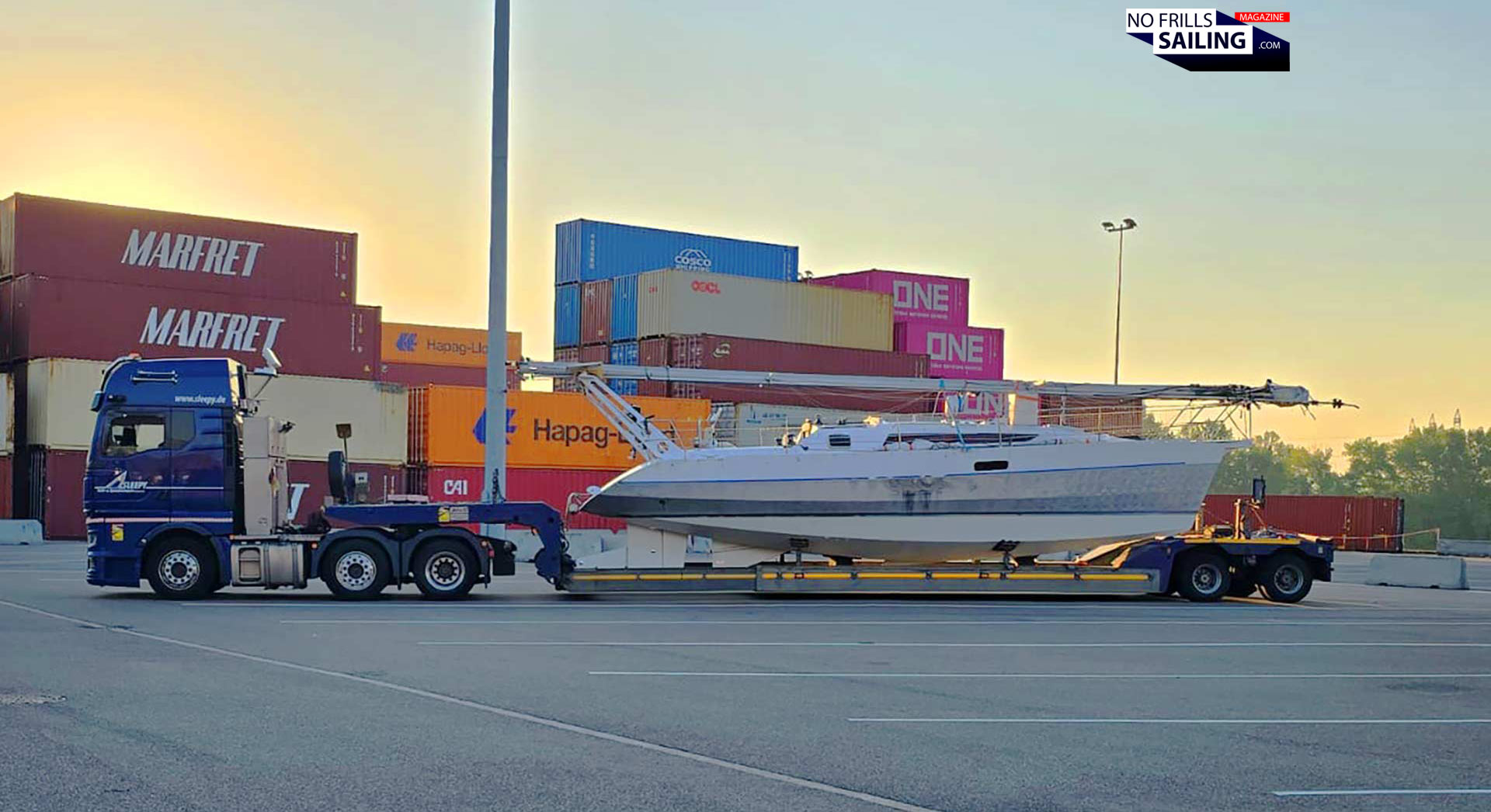
As a rookie driver, your first transport jobs assigned will be short distance, quick jobs. Like bringing a yacht from the marina to winter storage back and forth or hauling smaller boats (in terms of their sizes, measurements and weight) from town to town. The idea is to begin with “easy” loads and easy to drive roads. Incorporating as many loading and unloading processes for the driver to practice load securing procedures over and over again. Over time, as you progress and the kilometers begin to pile up, the company will entrust you with bigger yachts and longer, more complicated routes.
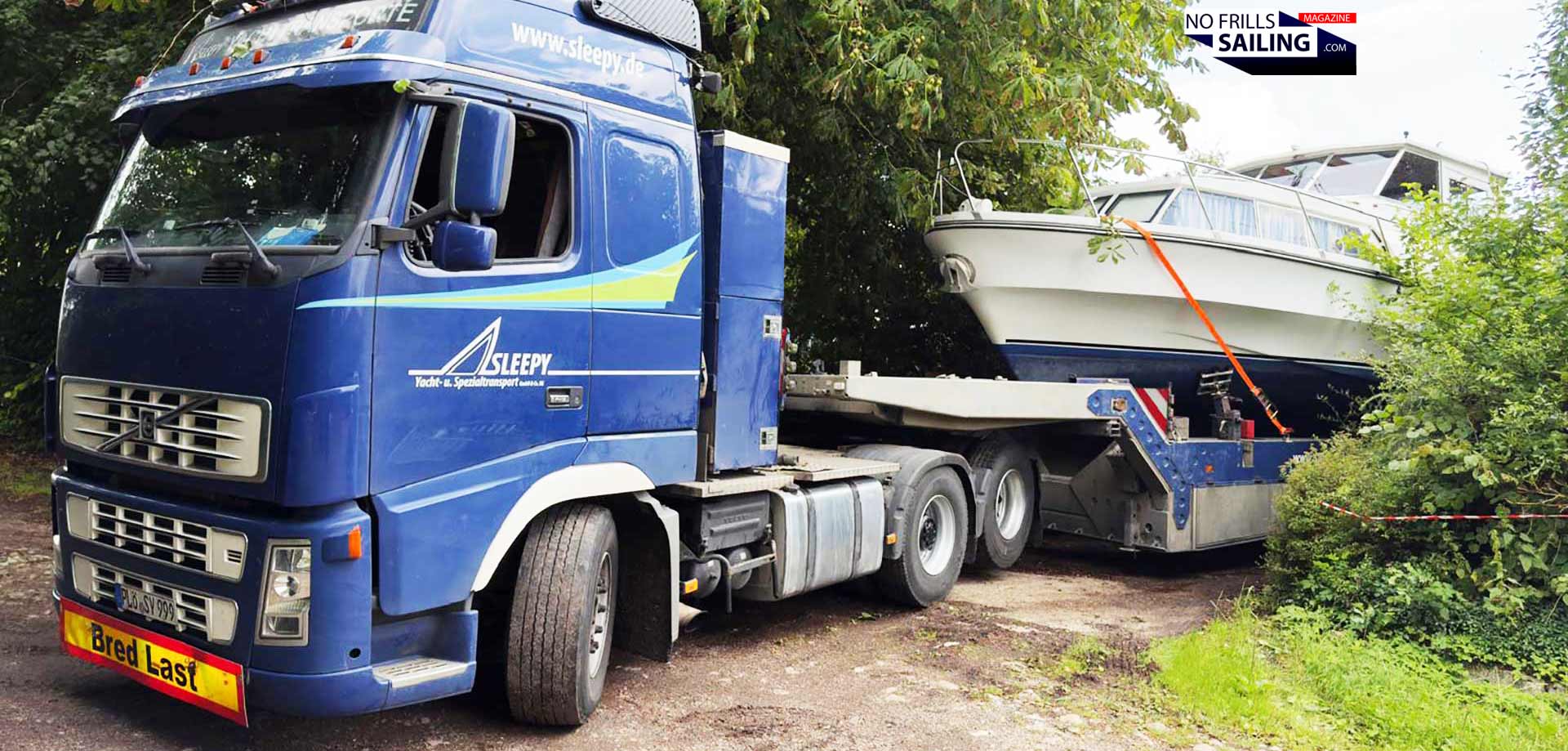
As with sailing as well, competence and reliability comes with practice. Flanked by driving safety courses and lots of maneuvering practice, a rookie driver will gain confidence and class. Up to a point when nothing can really shock you anymore: Every single one of the drivers has a compendium of hair-raising stories. Telling about the craziest roads (or no roads at all), hidden, narrow locations where boats needed to be taken from or brought to. Driving in icy, stormy, flooded conditions as well as situations us average driving-joes would immediately capitulate upon arrival.
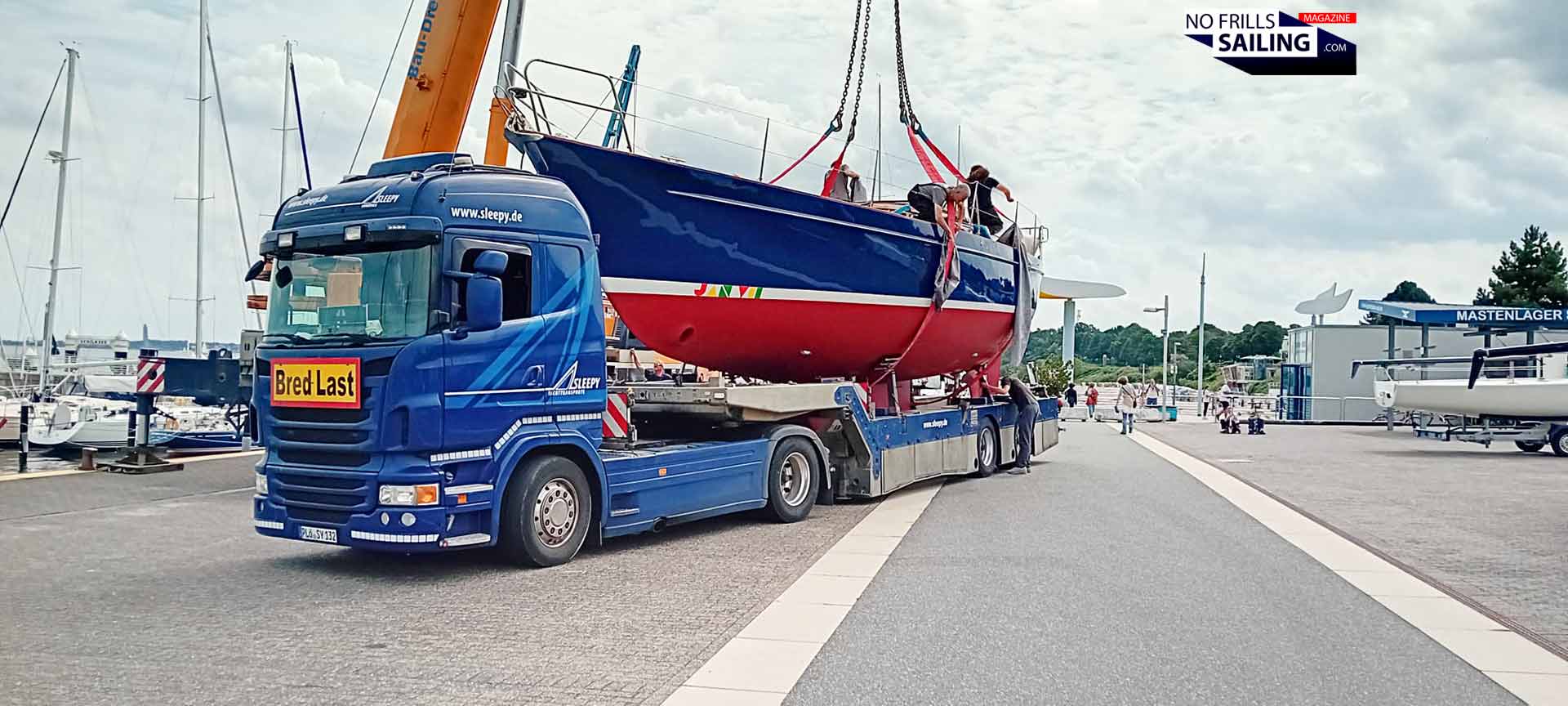
Central to the safety and damage-free transport of a boat is how it is loaded and secured once taken piggyback by the truck. Sleepy (and this is why they have this funny sounding company name) has its origins in winter storage. The boats needed to be driven from the harbors to the storage places (where they could “sleepy” well, that´s why “Sleepy”). So from the very first generation of drivers, being masters in loading and securing the precious yachts was a paramount competence of a Sleepy driver. In this, the company very early also developed their proprietary transport and cradle systems which have been refined and modernized over time as well. This is also a fascinating part of yacht transport
Individualized standard boat transport systems
There are basically two ways to transport your boat on a truck. The simplest way is that the trailer itself is the cradle. Telescopic supports are extended in a way that the hull´s underside is supported while the bulk of the ship´s weight rests on its keel. This is really something many people don´t know, but you boat (at least the ones with a fixed keel) basically stands on it when transported. The pillars are just supporting it: 80 to 90 percent of the boat´s weight rests upon the keel.

The second way of transport is hauling the boat and its cradle onto the trailer. Depending on what happens after the transport, cradle are the fastest and most convenient way in boat transport. Sleepy has developed its own system, with custom tailored cradles and trainers, which can move the cradle-boat-combos extremely fast and easy. Of course, this originated in their past main source of income, the winter storage. Hauling dozens of boats per day, hundreds per week made loading and offloading-time crucial. Also, this system enables the guys to park the yachts with minimum empty space between. Valuable knowledge and experience when transporting yachts as well.
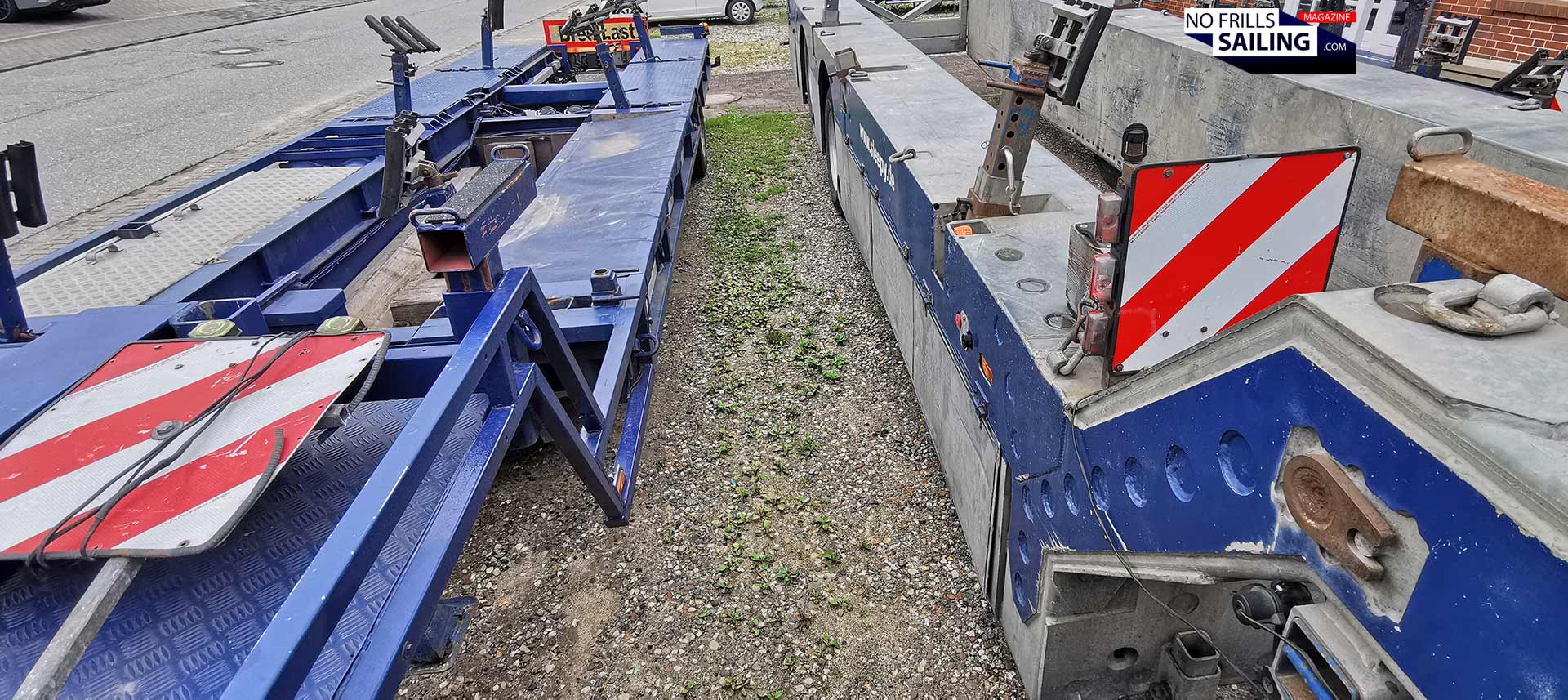
Sleepy is one of the major contractors and prime hauler for many yacht builders in Europe. This means, these shipyards have empty cradles on storage: When a boat is ready to be shipped, it´s already on their cradle, further minimalizing loading time. They have perfected this system over time, with special trailers and cradles for sailing yachts and power boats, fitting all sizes and measurements. The trailers themselves are also quite interesting pieces of equipment, boasting intricate hydraulic systems and possibilities to adjust to various boat sizes and shapes.
Yacht-transport truck driver´s wingman: The Pilot Cars
I was often kind of annoyed when proposing a yacht offer to potential clients and the bargaining started. As I said, achieving a good price is absolutely fine and everyone should go for it. But there is a fine line between bargain and audacity. I mean, if you go on and press your suppliers or service providers in admitting to lower and lower prices, receiving shitty service or low quality is the inevitable consequence. Many customers therefore tried to get down transport fees. And I admit, it´s a lot of money that such a road transport of your yacht is costing. Once wider than 3 meters, the heavy duty transport becomes subject of approval. And with this, hassle increases manifold.
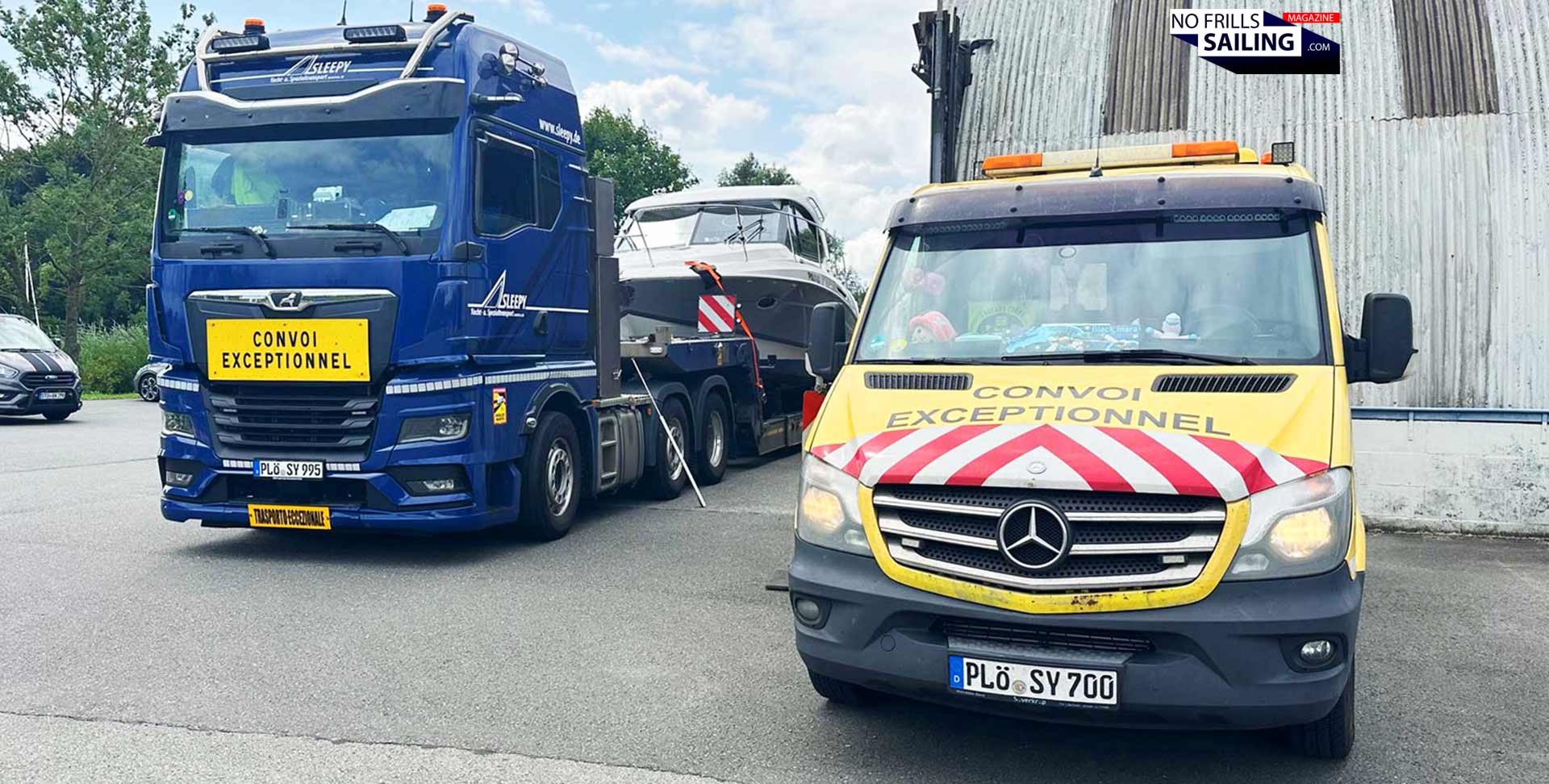
A large portion of cost related to yacht transports is because these need to be escorted by special built and equipped pilot cars. Usually, these are large vans equipped with either fixed or moving displays for warning signs. The duties of those pilot cars range from scouting missions to check out routes to flanking the transport either in front or – mostly – in the back of the lorry. The pilot cars will signal passing bans, speed limits or just that a heavy duty transport is ahead. Those cares can speed ahead and close crossings and provide many more forms of assistance underway.
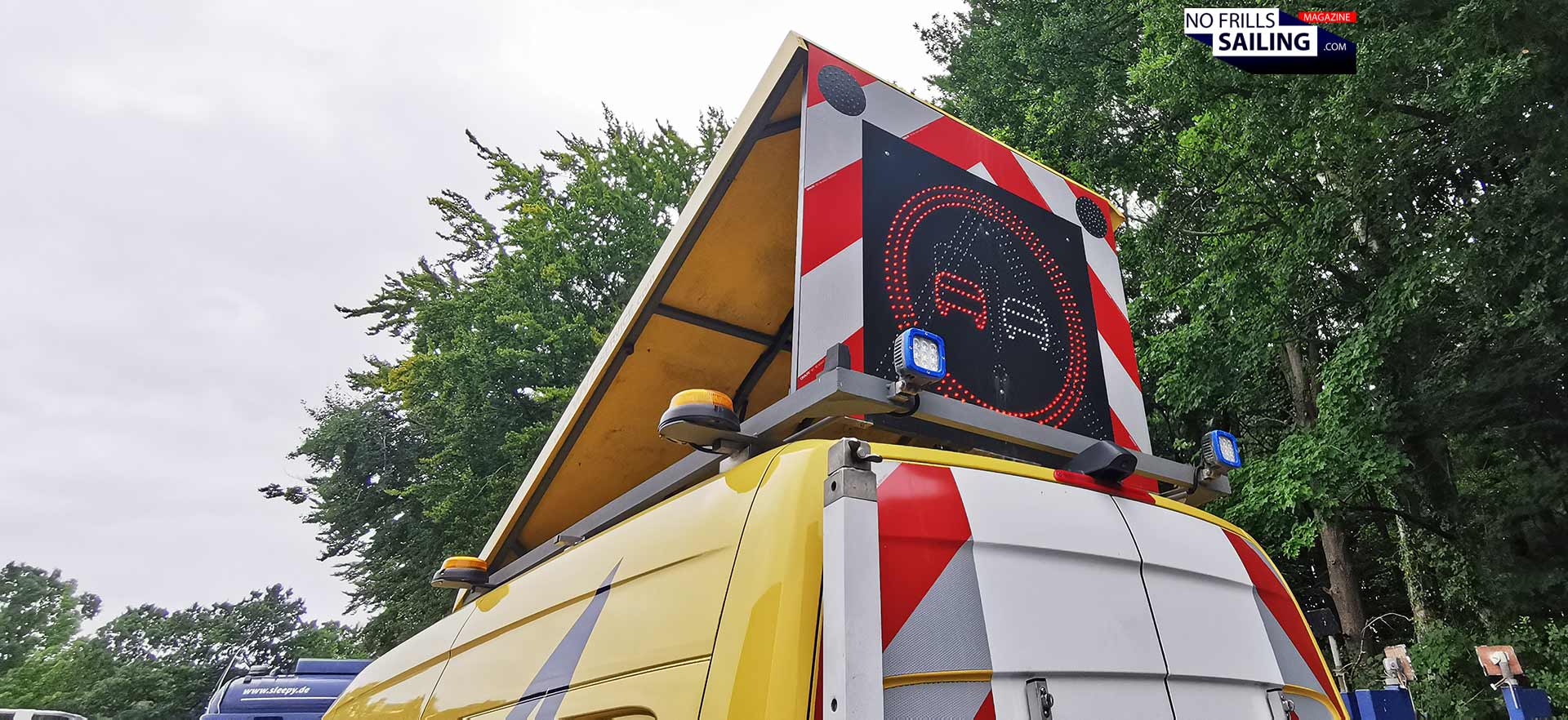
Usually, when the dispatcher contacts local authorities to register a transport, they will decide if and how many pilot cars need to be escorting a transport. This can vary from state to state, even from municipality to municipality. Sometimes, even police escorts are provided. Of course, this costs money. A lot. There´s at least a second driver to be paid, a second car, toll … you name it. As mentioned, there are different regulations and preconditions for pilot cars so that the drivers of those escorts may need to pass special national exams: Driving the yellow car in Germany doesn´t necessarily mean you can do it in Austria as well.
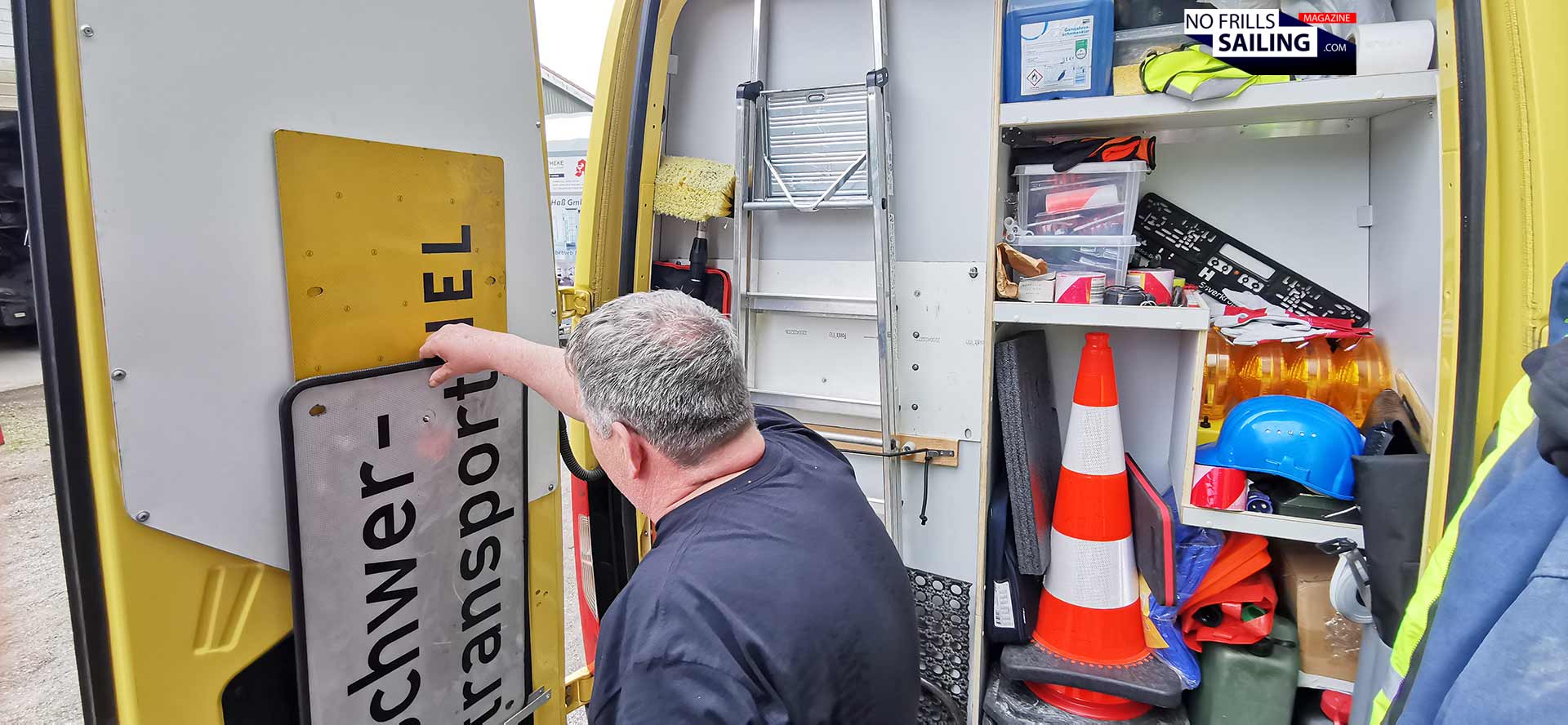
These pilot cars carry a large variety of warning signs in many languages. “Bred Last” in the Scandinavian and Nordic countries, “Convoi exceptionnel” for France and Belgium, “Warning” and many more. The bigger your boat, the more of these pilot cars may be needed: I´ve witnessed transports where two escorted the transport in the front and the back whilst a third one sprinted to the next crossing to make sure it´s empty once the truck arrived. This fact, this sheer effort to organize and pull off a transport is often neglected by boat buyers insisting that there “must be cheaper ways” to bring the boat to the coast. Well. Apparently. No.
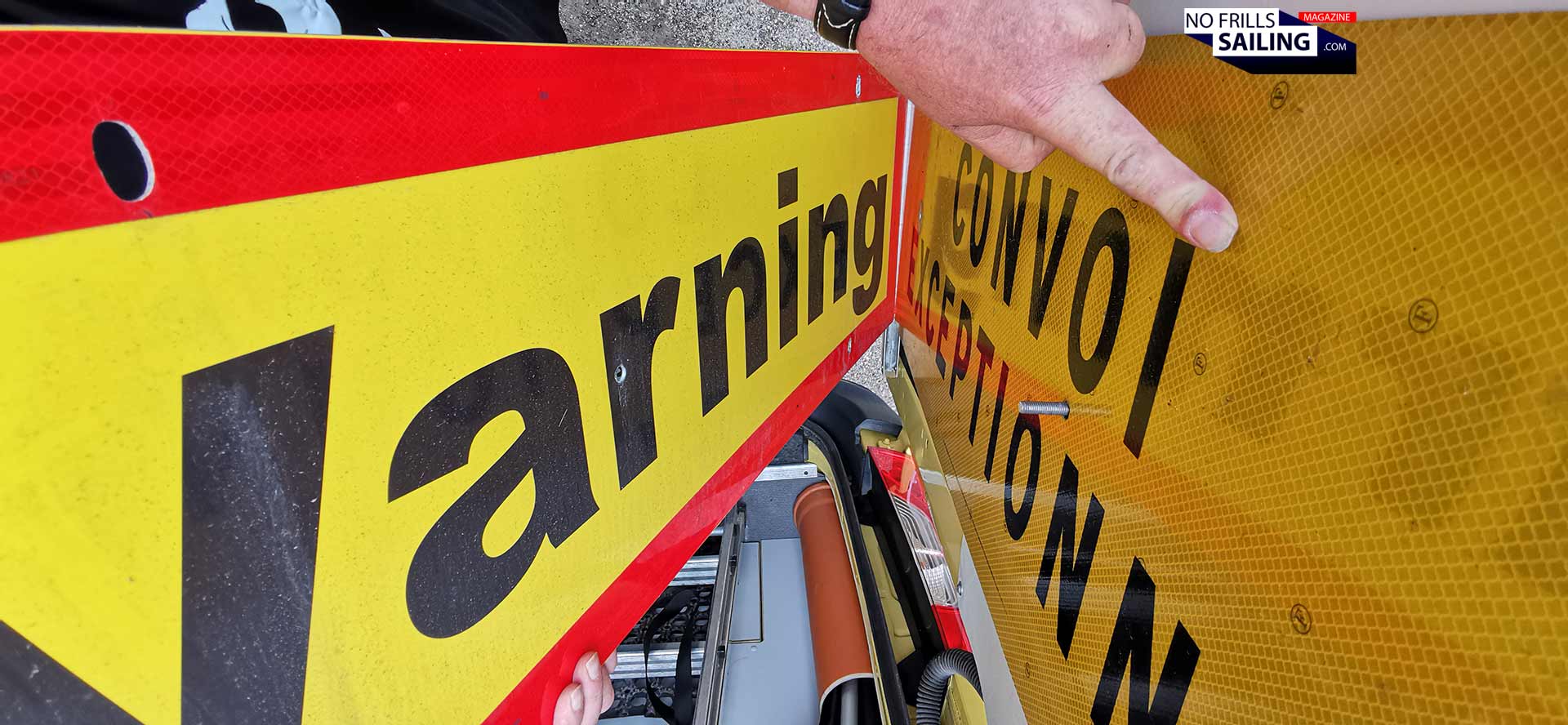
One thing often overseen as well is road safety and road planning. For the most part, a company like Sleepy knows its way around in Europe. With only so many shipbuilders and shipyards and only so many commissioning ports, most of the standard routes are well known. Planning, permissions from authorities and knowledge about neuralgic spots is a no-brainer. For some parts, shipyards have even helped to shape roadbuilding in their surrounding areas, such as yacht transport-proof on-ramps, large enough roundabouts or offloading areas. But sometimes, clients ask for “first time” transports.
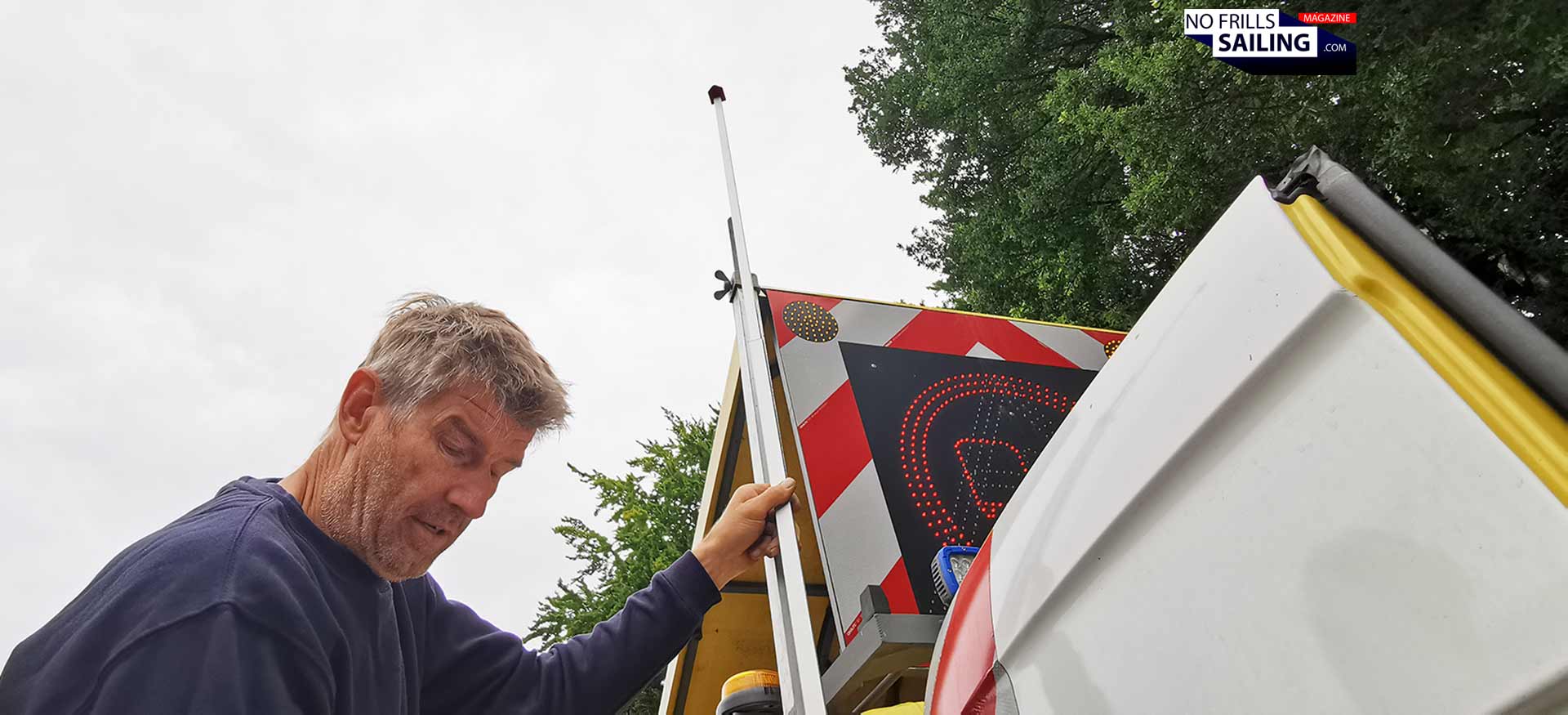
Most of the scouting can nowadays be done by internet thanks to digital means. But sometimes, a yellow pilot car needs to drive there and check: Width, ground clearance (over train crossings for example) or vertical clearance through tunnels or passing underneath bridges. Special “antennae” are mounted to the pilot car and adjusted to certain heights: It if hits a bridge, an alarm will go off. Imagine you have to pay a guy driving all the way from A to B to check if a route is feasible for your boat? Imagine this guy trying to find alternatives, when a newly built bridge turns out to be a road block.

Of course, pilot car´s drivers need to sleep somewhere too. That is why the back of these vans is often transformed into a caravan-like interior: There´s a large bed (much wider and more comfy than the slim bunk of the truck), stowage and even amenities like no-mix toilets or a little galley. Much more than trucks, pilot cars seem to be assigned to fewer drivers, judging by the amount of personal stuff in them.
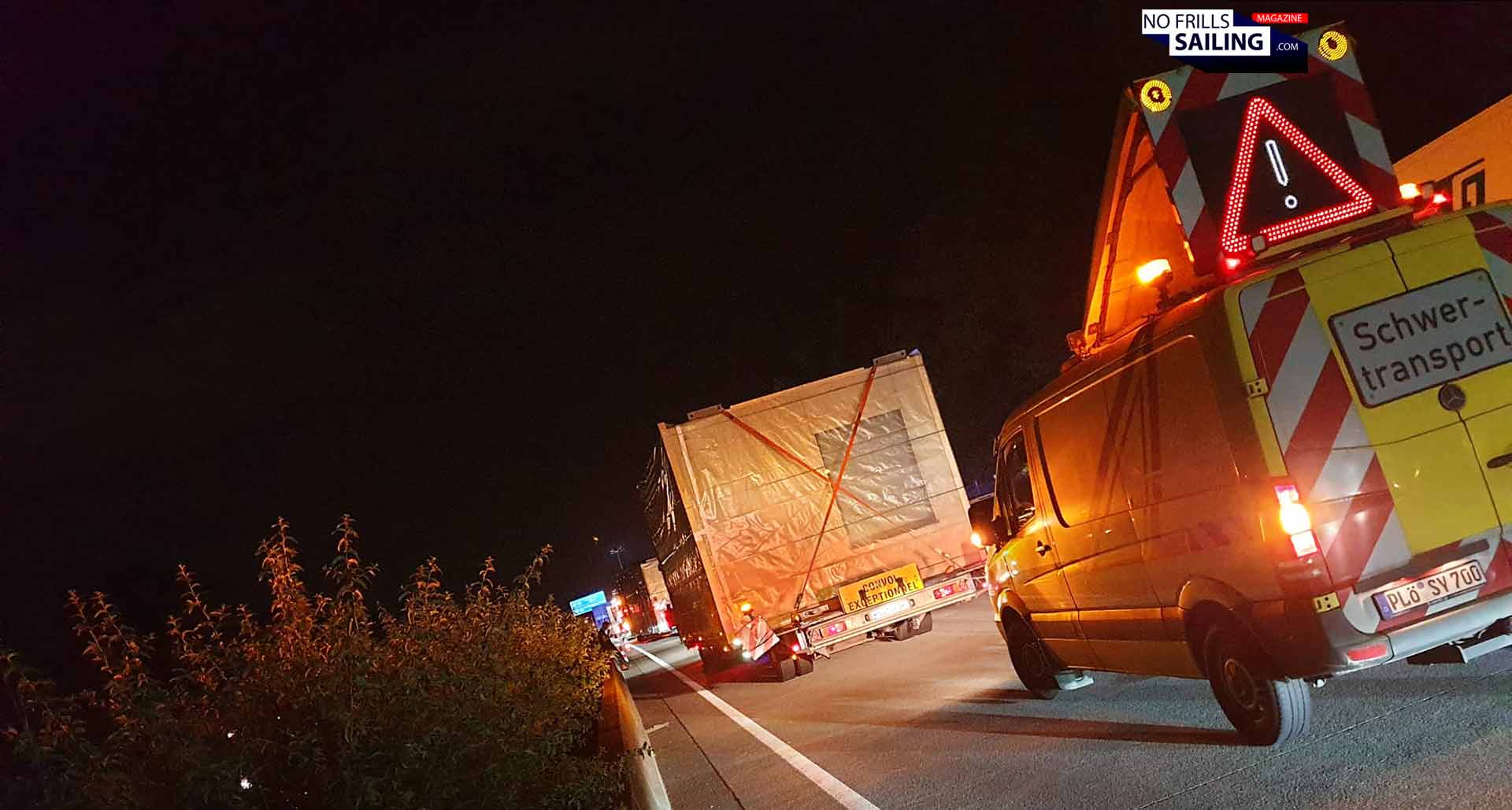
And here the circle closes: As much as relations between truckers have anonymized and maybe deteriorated over time, as closer even grew the relationship between truck and pilot car drivers. For boats wider than 3 meters, usually one pilot car at least is assigned. This is also where CB radio comes into play again: Chatting underway, occasional warnings and other information are exchanged here, mutual motivation on the often long and relatively eventless hours on the roads. Sometimes, this can even save lives, or, at least, your personal health and safety. Roadside robbery or truck drivers has sadly become a constant hazard, facing this threat as a team takes away some of the risk.
… whom honor is due.
I could go on talking about this field of yacht transport for hours. There is so much to discover here and certainly, every single one of the drivers has dozens of exciting, funny and also crazy, hair-raising stories to tell. I just hope that by reading this article you – dearest readers – got some more insight into this very important bit of yachting. If you are in process of buying a new yacht, please don´t press your dealer too much in terms of lower transport fares! You surely have undertaken a lot to being able to put down the budget for a brand new boat – make sure it reaches the sea safely.
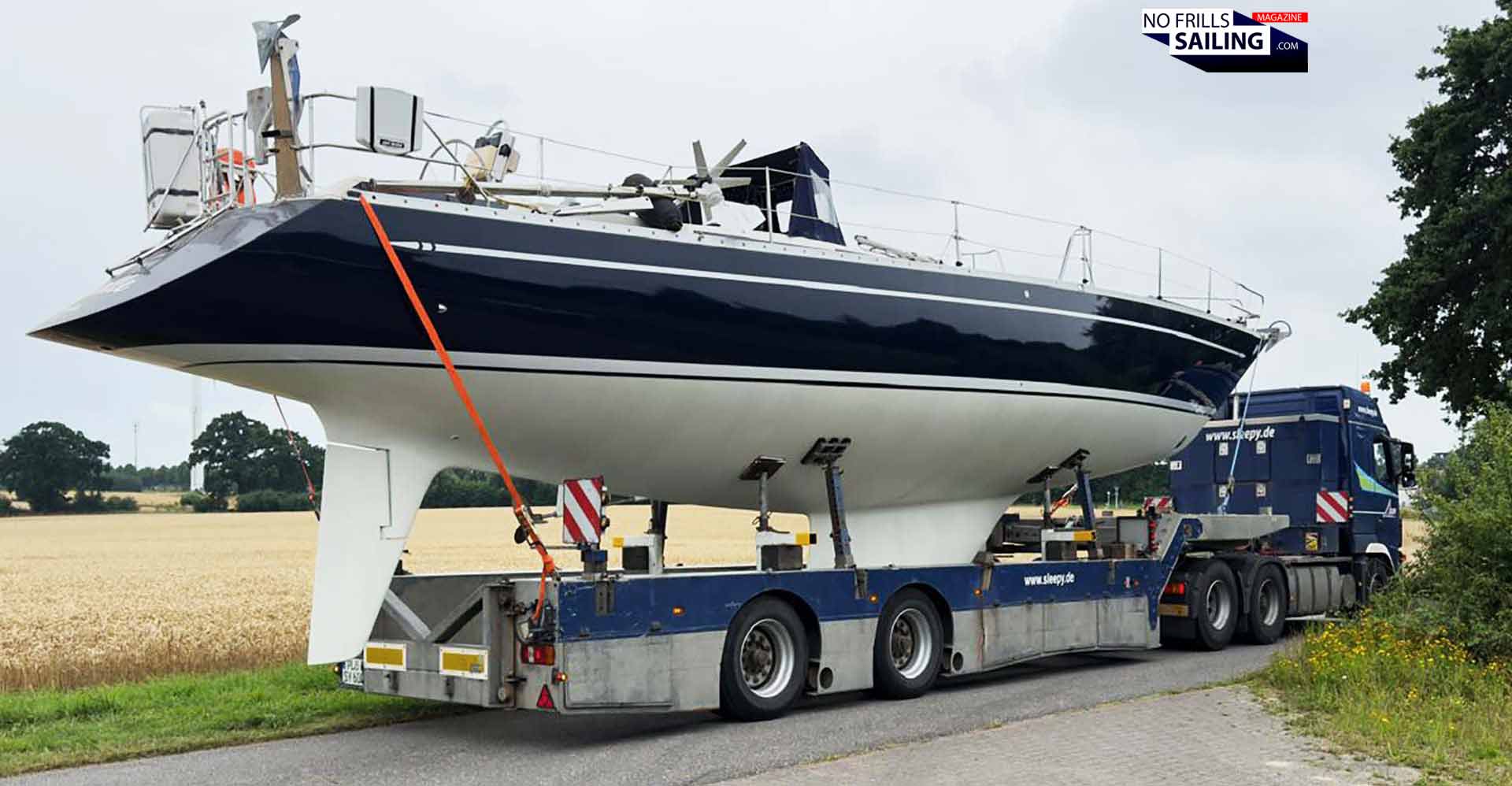
In order to do so, ask for specialized yacht transport companies which have a track record. There are many such companies, like Sleepy and Glogau for Germany (or German-built yachts), Augizeau for France or Bonati Trasporti for Italy. Don´t shave off too much budget so that your dealer will have no other choice as to employ no-name lowcost transports. No insurance, shitty hardware, untrained drivers and, for the perfect storm, no permissions are often the case. You don´t want to save a few hundred Euros on literally the last meters of your dream yacht becoming reality.
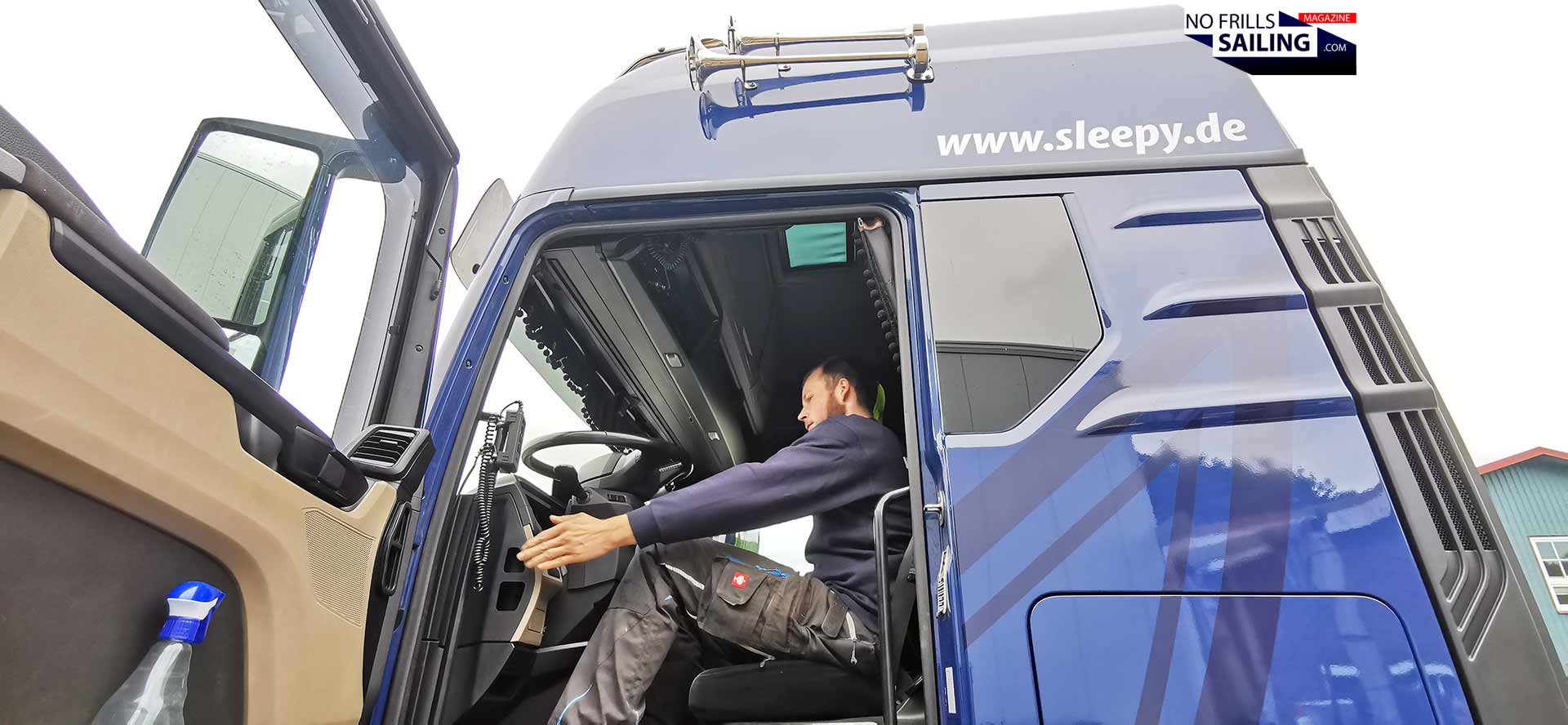
I say thanks guys for having me in your holy halls, thanks for opening the doors to your rolling homes. I have nothing less than admiration and respect for the incredible job you guys are pulling off – week by week, no matter how the weather, the road or the time pressure. Have a safe trip, guys, where ever you are right now!
Related articles you might find interesting as well:
Night flight boat transport: Last kilometers for a 50 feet through pitch black night
Yacht transport stunts during Covid
Yacht transport: My King´s Cruiser 33 finds a new spot for refit
